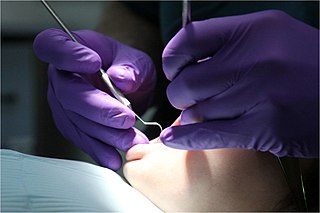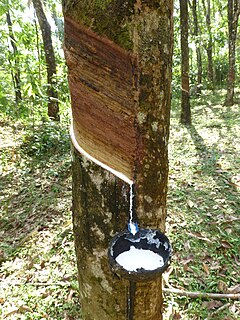
A condom is a sheath-shaped barrier device used during sexual intercourse to reduce the probability of pregnancy or a sexually transmitted infection (STI). There are both male and female condoms. With proper use—and use at every act of intercourse—women whose partners use male condoms experience a 2% per-year pregnancy rate. With typical use the rate of pregnancy is 18% per-year. Their use greatly decreases the risk of gonorrhea, chlamydia, trichomoniasis, hepatitis B, and HIV/AIDS. They also to a lesser extent protect against genital herpes, human papillomavirus (HPV), and syphilis.

Safe sex is sexual activity using methods or devices to reduce the risk of transmitting or acquiring sexually transmitted infections (STIs), especially HIV. "Safe sex" is also sometimes referred to as safer sex or protected sex to indicate that some safe sex practices do not completely eliminate STI risks. It is also sometimes used colloquially to describe methods aimed at preventing pregnancy that may or may not also lower STI risks.

Natural rubber, also called India rubber, latex, Amazonian rubber, caucho or caoutchouc, as initially produced, consists of polymers of the organic compound isoprene, with minor impurities of other organic compounds, plus water. Thailand and Indonesia are two of the leading rubber producers. Types of polyisoprene that are used as natural rubbers are classified as elastomers.

Petroleum jelly, petrolatum, white petrolatum, soft paraffin, or multi-hydrocarbon, CAS number 8009-03-8, is a semi-solid mixture of hydrocarbons, originally promoted as a topical ointment for its healing properties.

Anal beads are a sex toy consisting of multiple spheres or balls attached together in series which are continuously inserted through the anus into the rectum and then removed with varying speeds depending on the desired effect. Anal bead users enjoy the pleasurable feeling of the ball passing through the narrow sphincter of the anus.

Corn starch, maize starch, or corn flour is the starch derived from corn (maize) grain. The starch is obtained from the endosperm of the kernel. Corn starch is a common food ingredient, often used to thicken sauces or soups, and to make corn syrup and other sugars. Corn starch is versatile, easily modified, and finds many uses in industry such as adhesives, in paper products, as an anti-sticking agent, and textile manufacturing. It has medical uses as well, such as to supply glucose for people with glycogen storage disease.

An adhesive bandage, also called a sticking plaster, medical plaster, or simply plaster in British English, is a small medical dressing used for injuries not serious enough to require a full-size bandage. They are also known by the genericized trademarks of Band-Aid or Elastoplast . It was first invented in 1901 and popularised by Oskar Troplovitz, a German Jew from Gliwice city, although the idea was first contrived in 1880 by Germans Paul Carl Beiersdorf and Paul Gerson Unna, in Hamburg.

Personal lubricants are specialized lubricants used during human sexual acts such as intercourse and masturbation to reduce friction to or between the penis and vagina, anus or other body parts or applied to sex toys to reduce friction or to ease penetration. Surgical or medical lubricants or gels, which are similar to personal lubricants but not usually referred to or labelled as "personal" lubricants, may be used for medical purposes such as speculum insertion or introduction of a catheter. The primary difference between personal and surgical lubricants is that surgical lubricants are thicker, sterile gels, typically containing a bacteriostatic agent.

Latex allergy is a medical term encompassing a range of allergic reactions to the proteins present in natural rubber latex. Latex allergy generally develops after repeated exposure to products containing natural rubber latex. When latex-containing medical devices or supplies come in contact with mucous membranes, the membranes may absorb latex proteins. The immune system of some susceptible individuals produces antibodies that react immunologically with these antigenic proteins. As many items contain or are made from natural rubber, including shoe soles, elastic bands, rubber gloves, condoms, baby-bottle nipples, and balloons, there are many possible routes of exposure that may trigger a reaction. People with latex allergies may also have or develop allergic reactions to some fruits, such as bananas.

Medical gloves are disposable gloves used during medical examinations and procedures to help prevent cross-contamination between caregivers and patients. Medical gloves are made of different polymers including latex, nitrile rubber, polyvinyl chloride and neoprene; they come unpowdered, or powdered with corn starch to lubricate the gloves, making them easier to put on the hands.

A rubber glove is a glove made out of natural rubber or Synthetic rubber. Rubber gloves can be unsupported or supported. Its primary purpose is protection of the hands while performing tasks involving chemicals. Rubber gloves can be worn during dishwashing to protect the hands from detergent and allow the use of hotter water. Sometimes caregivers will use rubber gloves during the diaper changing process to prevent contact with the child's fecal material/urine. Health professionals use medical gloves rather than rubber gloves when performing surgical operations.

Latex rubber is used in many types of clothing. Rubber has traditionally been used in protective clothing, including gas masks and Wellington boots. Rubber is now generally being replaced in these application by plastics. Mackintoshes have traditionally been made from rubberized cloth.

Rubber tapping is the process by which latex is collected from a rubber tree. The latex is harvested by slicing a groove into the bark of the tree at a depth of one-quarter inch (6.4 mm) with a hooked knife and peeling back the bark. Trees must be approximately six years old and six inches (150 mm) in diameter in order to be tapped for latex.
Goldbeater's skin is the processed outer membrane of the intestine of an animal, typically an ox, valued for its strength against tearing. The term derives from its traditional use as durable layers interleaved between sheets of gold stock during the process of making gold leaf by goldbeating, as a batch process producing many "leaves" at the same time. In the early modern production of airships, application of its high strength-to-weight ratio and reliability were crucial for building at least the largest examples.

A female condom is a barrier device that is used during sexual intercourse as a barrier contraceptive to reduce the probability of pregnancy or a sexually transmitted infection (STI). Meant as an alternative to the condom for males, it was invented by Danish MD Lasse Hessel and designed to be worn internally by the female partner during vaginal sex to prevent exposure to ejaculated semen or other body fluids. Its protection against STIs is inferior to that of male condoms. Internal condoms can be used by the receptive partner during anal sex.

Condom effectiveness is how effective condoms are at preventing STDs and pregnancy. Correctly using male condoms and other barriers like female condoms and dental dams, every time, can reduce the risk of sexually transmitted diseases (STDs), including human immunodeficiency virus (HIV) and viral hepatitis. They can also provide protection against other diseases that may be transmitted through sex like Zika and Ebola. Using male or female condoms correctly, every time, can also help prevent pregnancy.
The history of condoms goes back at least several centuries, and perhaps beyond. For most of their history, condoms have been used both as a method of birth control, and as a protective measure against sexually transmitted diseases. Condoms have been made from a variety of materials; prior to the 19th century, chemically treated linen and animal tissue are the best documented varieties. Rubber condoms gained popularity in the mid-19th century, and in the early 20th century major advances were made in manufacturing techniques. Prior to the introduction of the combined oral contraceptive pill, condoms were the most popular birth control method in the Western world. In the second half of the 20th century, the low cost of condoms contributed to their importance in family planning programs throughout the developing world. Condoms have also become increasingly important in efforts to fight the AIDS pandemic. The oldest condoms ever excavated were found in a cesspit located in the grounds of Dudley Castle and were made from animal membrane. The condoms dated back to as early as 1642.

Latex is a stable dispersion (emulsion) of polymer microparticles in water. Latexes are found in nature, but synthetic latexes are common as well.
Vytex Natural Rubber Latex (NRL) is a brand of natural rubber latex produced and marketed by Vystar Corporation. Vytex NRL is an alternative material to petroleum-based synthetics and traditional, or Hevea, natural rubber latex. Protein test results show that Vytex NRL typically has 90% fewer antigenic proteins than Hevea natural rubber latex.

Moods Condoms is a manufacturer of condoms made from natural rubber latex. It is manufactured HLL Lifecare Limited, a Government of India undertaking. HLL was started off in 1966 with the objective of producing condoms for the National Family Planning Program. Moods Condoms came into existence in mid-1968, when HLL Lifecare Limited decided to develop a product to target the premium and upper middle class segment of the urban population in India. HLL today is one of the world's largest manufacturers of condoms. As of December 2012, its annual production totals around 800 million pieces across the globe.
















